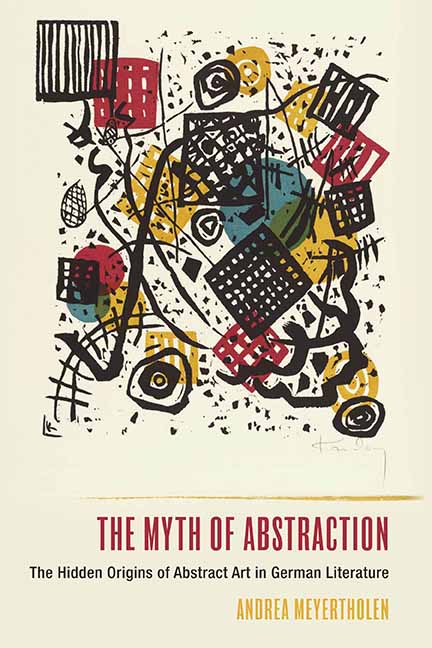Book contents
- Frontmatter
- Dedication
- Contents
- List of Illustrations
- Acknowledgments
- Introduction: The Many Origins of Abstract Art
- 1 Apocalypse Now: Heinrich Von Kleist’s Sublime Deframing of Caspar David Friedrich’s Der Mönch Am Meer (1810)
- 2 The Kleistian Sublime Is Now: Kazimir Malevich, Mark Rothko, Barnett Newman
- 3 The Clouding of Perception: Seeing The (Un)Real Potential for Abstraction in the Poetry and Science of Goethe’s Clouds (1821)
- 4 In the Service of Clouds or Optical Illusion?: Romanticism, Pointillism, and Impressionism
- 5 Driven to Distraction and from Abstraction: The Birth and Death of Abstract Art in Gottfried Keller’s Der Grüne Heinrich (1854/55, 1879/80)
- 6 Inside the Mind and Outside the Margins: The Unruly Lines of Paul Klee, André Masson, and Cy Twombly
- Epilogue: Laocoön and His Sisters: The Future of Literature and Art
- Bibliography
- Index
6 - Inside the Mind and Outside the Margins: The Unruly Lines of Paul Klee, André Masson, and Cy Twombly
Published online by Cambridge University Press: 07 May 2022
- Frontmatter
- Dedication
- Contents
- List of Illustrations
- Acknowledgments
- Introduction: The Many Origins of Abstract Art
- 1 Apocalypse Now: Heinrich Von Kleist’s Sublime Deframing of Caspar David Friedrich’s Der Mönch Am Meer (1810)
- 2 The Kleistian Sublime Is Now: Kazimir Malevich, Mark Rothko, Barnett Newman
- 3 The Clouding of Perception: Seeing The (Un)Real Potential for Abstraction in the Poetry and Science of Goethe’s Clouds (1821)
- 4 In the Service of Clouds or Optical Illusion?: Romanticism, Pointillism, and Impressionism
- 5 Driven to Distraction and from Abstraction: The Birth and Death of Abstract Art in Gottfried Keller’s Der Grüne Heinrich (1854/55, 1879/80)
- 6 Inside the Mind and Outside the Margins: The Unruly Lines of Paul Klee, André Masson, and Cy Twombly
- Epilogue: Laocoön and His Sisters: The Future of Literature and Art
- Bibliography
- Index
Summary
PAUL KLEE (1879–1940) COMPLETED the Bauchredner und Rufer im Moor (Ventriloquist and Caller in the Marsh, fig. 6.1) in 1923, nearly seventy years after his Swiss compatriot Gottfried Keller initially published Der grüne Heinrich and brought his unfortunate title artist with his doomed abstract artwork into existence. Despite the untimely discrepancy, the work is just as applicable to Keller's time as to Klee’s. The Bauchredner presents an imaging of the novel's central theme and the intended destination of Heinrich's long and winding road: the integration of the individual and the artist into society.
The painting's title figure calls out against a grid of darkening gradations, appearing unwelcome in the world around him and fundamentally incompatible with its rigidly set dimensions. Pushed outward from the picture plane, the title figure's disproportionately bulbous body cannot fit inside the rectangular boxes of the landscape behind him. His fleshy peach tones and his body's soft curves contrast starkly with the muted grays and greens of the landscape's tabular regularity. Although alienated, the Bauchredner still lives in the world as part of it, for the same matrix that bars his assimilation also prevents his escape. A rectilinear pattern runs through his insides to lock him in the grid. Like the fish caught in his lure between water and air and his positioning on the canvas, he occupies an uncertain place in this world, belonging neither to light nor dark, right nor left, top nor bottom. He floats in the center and strives upward, but his feet never leave the solidity of a ledge bent once upward and again downward. He is at home nowhere and communicates with no one, although his inaudible call suggests his yearning for both.
Like the curvilinear Bauchredner, the protagonist of Der grüne Heinrich is at odds with objective society, unable to constrain his excessive subjectivity within its rigidly linear mold for subjecthood. Time and again, Heinrich fails to align himself with the expectations for responsible citizenship when his egocentric impulses and solipsistic behavior thwart his sincere desire to join the social whole as an artist. Sharing the Bauchredner's in-between status, Heinrich cannot fit inside the box meant for the artist, but he also cannot fully disentangle himself from the social network.
- Type
- Chapter
- Information
- The Myth of AbstractionThe Hidden Origins of Abstract Art in German Literature, pp. 207 - 242Publisher: Boydell & BrewerPrint publication year: 2021



